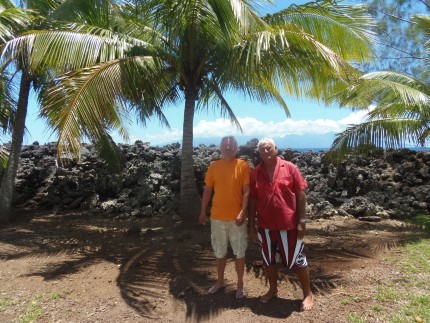The mysterious disappearance of tūāhu

Professor Jeff Sissons and local leader Ato Fogier standing in front of a ruined Marae in Moorea
Posted: Thu, 3 Nov 2016
One of the great mysteries of Maori cultural history is the absence of tūāhu (shrines) from New Zealand’s archaeological record. Tūāhu were the closest equivalents to the temples and marae of Eastern Polynesia.
In a newly funded Marsden project, Associate Professor Jeff Sissons of Victoria University of Wellington will determine if this gap in Māori historical knowledge is due to the removal of tapu by rites that were performed in the mid-nineteenth century.
Associate Professor Sissons suggests that during this time Māori chiefs and priests sought to realise new political and personal visions within a now Christianised society. While tapu was understood as foundational to the pre-Christian political and economic life, it became a threat to post-Christian life.
In his recently published Marsden-funded book “The Polynesian Iconoclasm: Religious Revolution and the Seasonality of Power”, Associate Professor Sissons shows that widespread destruction of images, temples and marae preceded mass conversions of Maori to Christianity in the 1840s.
At the heart of tapu-removing events lie the activities of the Taranaki priest, Tamati Te Ito, the leader of a Christian movement that came to be known as Kaingarara (Reptile-eaters). During the 1850s, Te Ito performed public rites to remove tapu in wāhi tapu (sacred groves), where tūāhu were often located. Such rites spread to other regions, including Northland and the lower South Island.
Associate Professor Sissons will document more fully the development and influence of Tamati Te Ito’s tapu-removal movement and its impact on the sacred and political landscape of Māori throughout Aotearoa.
This project will contribute towards Māori knowledge of sacred sites and help explain contemporary relationships between iwi and wāhi tapu.
Total Funding: $390,000 (excl. GST) for 3 years
Researchers: Associate Professor Jeff Sissons, School of Social and Cultural Studies, Victoria University of Wellington, PO Box 600, Wellington 6140
